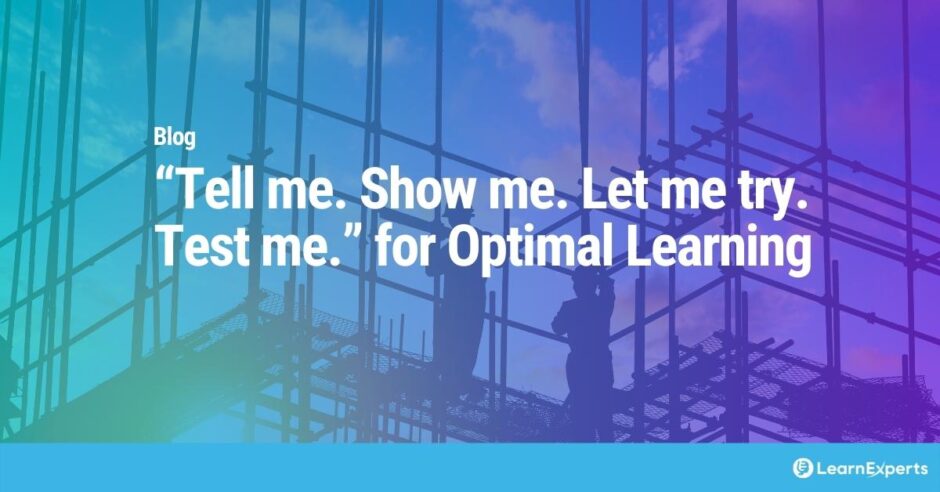Experienced course developers and trainers typically follow proven learning models – Bloom’s Taxonomy, ADDIE or the Kirkpatrick Model. But to meet today’s need to roll out fast but effective training programs, I use a spin-off that is very much based on the tried-and-true training methodologies. While the name “Tell me. Show me. Let me try. Test me.” may seem long, when I tell people about it, they get it.
So, what is “Tell me. Show me. Let me try. Test me.”? It’s a framework to help structure training that promotes good learning outcomes. It is relatively simple to understand and implement – tell the learner the concepts they are going to learn about, show them the concepts, let them try on their own by allowing them to do the practical application, and then test them to see if they have understood the concepts.
If you follow this structure or flow, there is a guaranteed learning outcome where the learner will retain what they need to know (it might take a few more “let me trys” to grasp complex concepts).
What works for learning
People often ask me whether these frameworks work? It used to be that people would refer to the Learning Pyramid or Cone of Learning but this learning theory has been widely denounced as it has been misapplied and there are no conclusive evidence to back up the quoted average retention rates.
However, a study by John Dunlosky, Katherine A. Rawson, Elizabeth J. Marsha, Mitchell J. Nathan and Daniel T. WIllingham, reviewed more than 700 scientific articles on 10 commonly used learning techniques and they provided their recommendations on the best learning techniques.
Their recommended techniques are useful in a range of learning conditions, assist learners of various ages, abilities, and levels of prior knowledge—and have been tested in a classroom or other real-world situation. To receive a recommendation from the group, there must be evidence that learners are able to use the method to master a variety of subjects, and their grades should benefit no matter what kind of assessment is used to measure learning.
Here is what they found.
Distributed Practice
In this technique, learning is distributed over time. In an analysis of 254 studies involving over 14,000 participants, learners recalled considerably more after spaced study than after cramming. In one study, 30-day delays improved performance more than lags of just one day. Another study found peak performance came when sessions were spaced at about 10% to 20% of the retention interval.
An interesting note by the authors is that to remember something for one week, learning episodes should be 12 to 24 hours apart. To remember something for five years, lessons should be spaces six to 12 months apart. Learners actually do retain information during these long intervals, and they quickly relearn what they’ve forgotten.
Self-Testing
This technique does not evaluate knowledge but rather it provides learners the ability to practice what they self-test they don’t know. Hundreds of experiments show that practice testing triggers a mental search of long-term memory that activates related information, forming multiple memory pathways that make the information easier to access.
Applying Tell Me. Show me. Let me try. Test me
The “Tell Me. Show me. Let me try. Test me.” leverages the best practices described by Dunlosky and team. Tell the learner multiple times about the concepts that they need to know and then provide an opportunity for self-testing.
The other benefit of the “Tell Me. Show me. Let me try. Test me.” framework is that it also builds the foundation of the course that then can be used any way you want, but still drives a good learning outcome. You can take pieces from it and build instructor-led training or online learning or microlearning or other types of learning.
The role of LEAi in “Tell Me. Show me. Let me try. Test me.”
When we built LEAi, we knew that some of our users were not going to be training experts, yet we needed to ensure that they followed this framework for optimal learning outcomes.
That is why we designed the product so that they upload the raw content from the subject-matter experts and LEAi automatically develops the training content that follows the “Tell Me. Show me. Let me try. Test me.” Framework.
Content Type and Audience
Once the foundation of the course structure is built, then the course creator can choose whichever output they would like to create (videos, the instructor-led training, or whatever modality they want to use to train people) all from the same source. Reuse content from SMEs to build the foundation of the course and then reuse that content to deliver the course however you need to.
The tool today is used for multiple audiences from product organizations building product training to HR groups that need a fast way to generate new hire onboarding or add their own spin on generic compliance training, sales and partner executives that are enhancing sales and partner enablement programs, and learning teams who need more efficiency to scale to the demands of the company.
If you want to learn more about the “Tell Me. Show me. Let me try. Test me.” framework, drop me a note. We would also be happy to give you a quick demo on our LEAi product.
Last Updated : March 10, 2025

